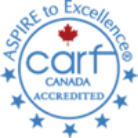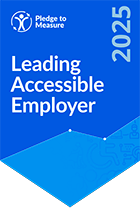News
5 Tips to Make Your Communication More Inclusive and Accessible for All
Creating an inclusive society begins with effective communication that acknowledges and respects the diversity of all individuals. According to the 2022 Canadian Survey on Disability, 8 million Canadians aged 15 and older live with one or more disabilities. Many face significant barriers to employment, financial security, access to services, and social inclusion. Inclusive communication is key to breaking down these barriers, fostering environments where everyone feels valued and empowered to participate fully in society.
In alignment with the 2024 Government of Canada's Accessibility Resource Centre guidelines, we want to share five actionable tips to enhance communication that will enhance accessibility and inclusion in your personal and professional life.
- Use Inclusive and Empowering Language
Words have the power to shape both perceptions and lived experiences. Inclusive language is rooted in respect, ensuring that communication avoids reinforcing stereotypes while fostering empathy and understanding. More than avoiding offense, inclusive language actively challenges biases, promotes equity, and removes barriers. By choosing empowering phrases, we cultivate a culture of diversity and inclusion. For instance, describing someone as “a person living with a disability” highlights their resilience and humanity rather than evoking pity. Here are some practical ways to implement inclusive language effectively:
- The use of Person-First Language and Identity-First Language are two approaches to discussing disabilities, each offering a unique perspective. Person-first language focuses on the individual, using terms like “person with a disability” or “person with Down syndrome.” Identity-first language, on the other hand, emphasizes disability as an integral part of identity, such as “disabled person,” “Deaf person,” or “blind person.” Preferences can differ greatly; for instance, in New Zealand, identity-first language is often encouraged, though person-first terms remain common. Since there’s no universal standard, we suggest asking individuals or groups about their preferred language.
- Avoid Negative Connotations: Replace phrases like “confined to a wheelchair” with “a person who uses a wheelchair,” which reframes the narrative to highlight mobility rather than restriction.
- Choose Neutral Terms: Use “disability” or “accessible needs” rather than outdated terms like “special needs” or “handicapped,” which can feel patronizing.
- Focus on Strengths: Highlight contributions, e.g., “a skilled graphic designer with a disability” instead of “a disabled graphic designer.”
- Steer Clear of Metaphors: Avoid expressions like “crippling debt” or “turning a blind eye,” as these trivialize genuine challenges faced by individuals with disabilities.
2. Enhance Visual Representation
Images and visuals are powerful tools for communication. To promote accessibility and inclusion, ensure that the visuals you use reflect the diversity of your audience. Represent individuals from various backgrounds, abilities, and experiences to show that everyone belongs.
- Show Diversity: Use images depicting individuals with disabilities actively engaged in work, learning, sports, or social activities to challenge stereotypes.
- Include Alt Text: Provide descriptive alt text for digital images, ensuring people using screen readers can access visual content. For example, instead of “Image of a woman at work,” write, “Image of a woman in a wheelchair presenting a report at a workplace meeting.”
- Prioritize Accessibility in Design: Use high-contrast visuals, readable fonts, and accessible formats like braille or large print.
3. Make Content Accessible Across Platforms
Accessibility extends to how your content is delivered. Use plain language to ensure your message is clear and understandable. Avoid jargon or overly complex terminology that may alienate some audience members.
For digital platforms, adhere to Web Content Accessibility Guidelines (WCAG) to ensure your content is navigable for individuals using assistive technologies. Examples include using high-contrast colors, providing captions for videos, and ensuring keyboard navigation functionality.
4. Practice Active Listening and Feedback
Effective communication is a two-way street. To promote accessibility and inclusion, practice active listening and encourage feedback. When communicating with individuals, especially those with disabilities, listen attentively without interrupting. Show genuine interest by asking clarifying questions and paraphrasing to confirm understanding.
Create an environment where feedback is welcomed and valued. For instance, after a presentation or event, ask participants for suggestions on how to improve accessibility and inclusion efforts. This input will help you make informed decisions and demonstrate a commitment to continuous improvement.
5. Tailor Communication to Individual Needs
Recognizing that everyone communicates differently is key to fostering inclusivity. Adapt your communication style to meet individual needs, whether it involves using sign language interpreters, large-print materials, or assistive technologies.
Before meetings or events, proactively ask participants about their accessibility requirements. This practice not only ensures effective communication but also shows respect and consideration for diverse needs.
Effective communication requires a thoughtful, case-by-case approach
Effective communication requires a thoughtful, case-by-case approach. Preferences for describing disabilities vary among individuals and evolve over time, reflecting the diverse experiences and perspectives of those within the disability community. Each person navigates society and the world differently, making it essential to respect their unique preferences. When in doubt, simply ask which terms they prefer. Approaching these conversations with kindness, openness, and curiosity fosters mutual understanding and respect.
At its core, effective communication is the foundation of accessibility and inclusion. By adopting inclusive language, showcasing diversity in visuals, ensuring content accessibility, practicing active listening, and tailoring communication to meet individual needs, we can create environments where everyone feels valued and empowered. Organizations that embrace accessibility go beyond compliance; they help build a society where everyone can thrive and contribute meaningfully!
At Open Door Group, accessibility is central to everything we do. We design inclusive services that cater to diverse needs, ensuring everyone has the opportunity to succeed. Access our services to individuals here: https://www.opendoorgroup.org/services/for-individuals
For more resources, visit the Government of Canada’s Accessibility Resource Centre.
#InclusiveCommunication #AccessibleLanguage #DiversityInclusion #CommunicationTips #AccessibleSociety #DisabilityAwareness #EmpowermentThroughLanguage




